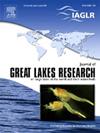Full year seasonality of benthos in the nearshore of Lake Superior
IF 2.5
3区 环境科学与生态学
Q3 ENVIRONMENTAL SCIENCES
引用次数: 0
Abstract
Relatively little is known about the full-year dynamics of benthic invertebrates in seasonally-freezing lakes. In this study, we describe the seasonal variability in benthic invertebrate abundance and coarse-level taxonomic composition across five nearshore locations in Lake Superior, with a focus on the winter period. We found that benthos abundances were relatively stable across the year, with similar winter (2294 ± 987 SD ind. m−2) and summer densities (2710 ± 1445 SD ind. m−2) across all stations. Community composition was also relatively stable across the year at our study stations, with Hexagenia sp., chironomids, and oligochaetes dominating our shallowest station (Duluth Harbor) and oligochaetes, Diporeia sp., and clams (Sphaeriidae) dominating deeper locations. Across all stations, diversity was similar across seasons, with the highest number of taxa observed in the fall (5.4 ± 1.8) and lowest number in the summer (4.5 ± 1.4). We found that the winter-spring period was an important time for the reproduction of the Lake Superior keystone amphipod Diporeia sp. Finally, we show that community structure was more variable across sites than across seasons. This is one of very few studies of winter benthos in the Great Lakes and suggests that benthic invertebrate communities show muted seasonal variability compared to planktonic organisms.
苏必利尔湖近岸底栖生物的全年季节性
人们对季节性冰冻湖泊中底栖无脊椎动物的全年动态知之甚少。在这项研究中,我们描述了苏必利尔湖五个近岸地点底栖无脊椎动物丰度和粗分类组成的季节性变化,重点是冬季。我们发现,底栖生物丰度在全年中相对稳定,所有站点的冬季密度(2294 ± 987 SD ind. m)和夏季密度(2710 ± 1445 SD ind. m)相似。在我们的研究站位,群落组成在全年中也相对稳定,最浅的站位(德卢斯港)以匙形目、摇蚊和寡毛类为主,而较深的站位则以寡毛类、匙形目和蛤蜊(Sphaeriidae)为主。在所有站点,不同季节的多样性相似,秋季观察到的分类群数量最多(5.4 ± 1.8),夏季最少(4.5 ± 1.4)。我们发现,冬春季节是苏必利尔湖基石片脚类动物繁殖的重要时期。最后,我们发现群落结构在不同地点的变化比在不同季节的变化更大。这是极少数有关五大湖冬季底栖生物的研究之一,表明与浮游生物相比,底栖无脊椎动物群落的季节变化较小。
本文章由计算机程序翻译,如有差异,请以英文原文为准。
求助全文
约1分钟内获得全文
求助全文
来源期刊

Journal of Great Lakes Research
生物-海洋与淡水生物学
CiteScore
5.10
自引率
13.60%
发文量
178
审稿时长
6 months
期刊介绍:
Published six times per year, the Journal of Great Lakes Research is multidisciplinary in its coverage, publishing manuscripts on a wide range of theoretical and applied topics in the natural science fields of biology, chemistry, physics, geology, as well as social sciences of the large lakes of the world and their watersheds. Large lakes generally are considered as those lakes which have a mean surface area of >500 km2 (see Herdendorf, C.E. 1982. Large lakes of the world. J. Great Lakes Res. 8:379-412, for examples), although smaller lakes may be considered, especially if they are very deep. We also welcome contributions on saline lakes and research on estuarine waters where the results have application to large lakes.
 求助内容:
求助内容: 应助结果提醒方式:
应助结果提醒方式:


